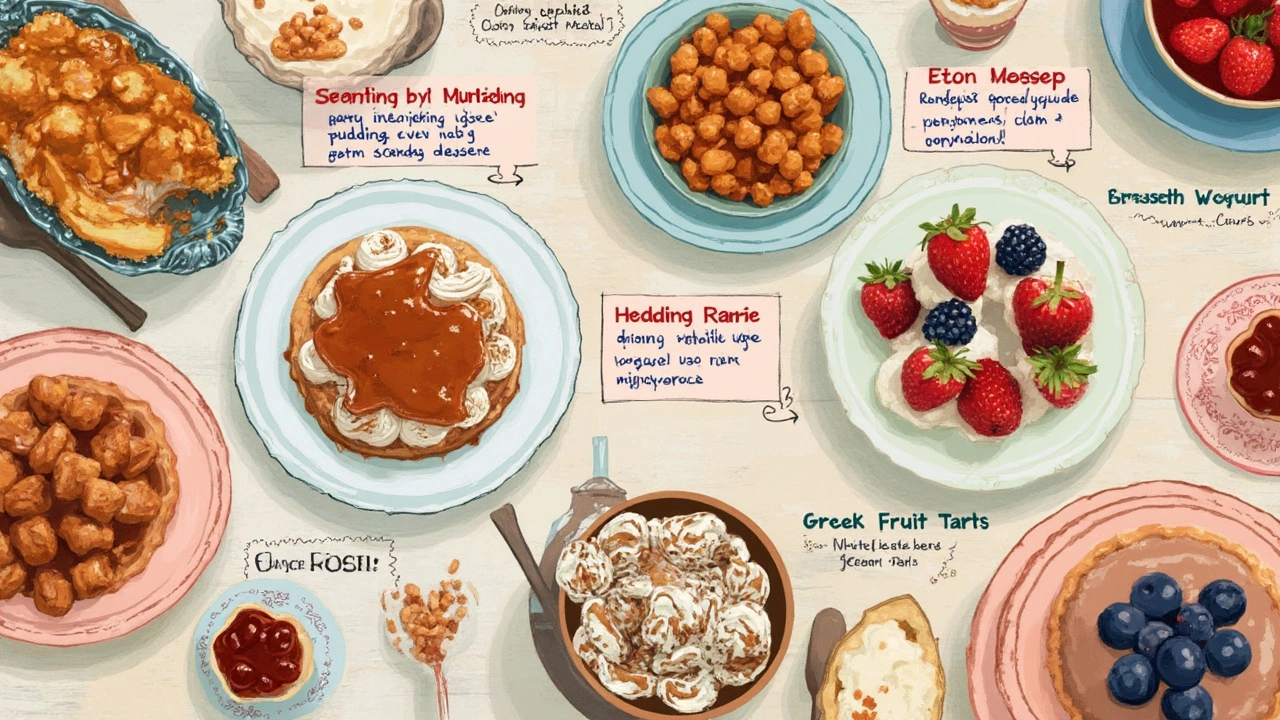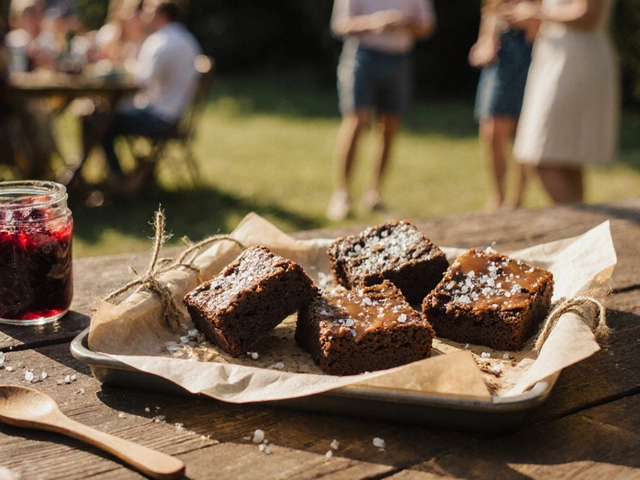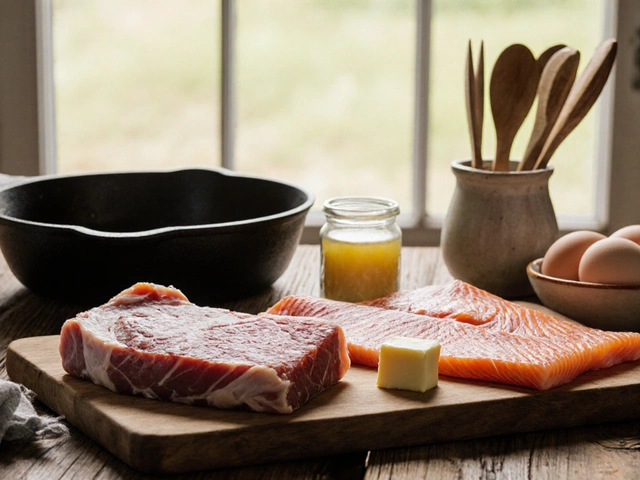
Ever feel like dessert menus are loaded with landmines? Turns out, some of the sweetest picks are loaded with way more sugar than you’d guess—one slice of cake can hit your daily limit with just a few bites. The crazy thing? Some desserts look “light” but sneakily pack in extra calories with hidden fats or added syrups.
Reading ingredient lists is more than just a boring habit—it's how you spot the real troublemakers. Those colorful bakery pastries, loaded milkshakes, and even your favorite ice cream can bring way more than just a sugar rush. If you’ve ever wondered why you feel sluggish after dessert, it’s probably the sugar-fat combo hitting harder than you expected.
- Desserts That Pack a Sugar Punch
- Hidden Fat Bombs Dressed as Sweets
- The Great 'Healthy Dessert' Illusion
- Why Size Matters: Oversized Treats
- Smart Hacks to Curb Dessert Damage
Desserts That Pack a Sugar Punch
Here’s the honest truth: a lot of classic desserts deliver several days’ worth of sugar in one small serving. Take a look at bakery muffins, frosted cinnamon rolls, or store-bought cheesecake. One average slice of cheesecake brings around 30 grams of sugar, which is close to what the American Heart Association says you should have in an entire day. Huge frosted cupcakes and loaded doughnuts can hit 40–50 grams in just a few bites.
Some of the worst offenders might surprise you. The sauces, jams, or fruit syrups on pancakes and Belgian waffles make these dishes even sweeter than they seem. Even so-called "fruit tarts" often use extra-sweetened fillings and a sugary glaze on top. It’s not just the usual desserts, either—frozen yogurt chains and smoothie bowls pack hidden sugars through sweet toppings, sprinkles, and chocolate or caramel drizzle.
Here are a few examples of desserts to avoid if you’re watching your sugar intake:
- Sugar-loaded milkshakes (some large sizes up to 80g sugar—like three cans of soda!)
- Double-layer or frosted cakes (can hit 60g per slice)
- Packaged pastries (a single Danish: up to 30g sugar)
- Boba or bubble teas (large cup with sweet toppings often exceeds 50g)
To be safe, always double-check nutrition labels, even on treats that “look” light. Restaurant menus almost never list the actual sugar content, so when picking dessert, smaller is usually smarter. If in doubt, go for fresh fruit with some whipped cream on the side—it’s way less likely to spike your sugar levels.
Hidden Fat Bombs Dressed as Sweets
Just because a dessert doesn’t taste super oily doesn’t mean it’s not loaded with hidden fats. Croissants, danishes, or flaky pastries are basically butter delivery devices—one almond croissant can sneak in over 25 grams of fat, sometimes more than a cheeseburger. Even those ‘healthy’ muffin options can have as much fat as a glazed donut, without any of the fun.
The main offenders in the fat department are anything creamy or extra flaky. Cheesecakes, custard pies, ice cream sundaes, and tiramisus top the list. Most of the fat in these comes from butter, heavy cream, or full-fat cheese. Trans fats—the kind your heart especially hates—are still found in store-bought frostings and pie crusts. News flash: The American Heart Association says,
“Trans fats raise your bad (LDL) cholesterol levels and lower your good (HDL) cholesterol levels, increasing your risk of heart disease.”
If you spot ‘partially hydrogenated oil’ in the ingredients, that’s your signal to put it back on the shelf.
- Store-bought cakes and pies usually beat homemade ones for hidden saturated and trans fats.
- Chocolate lava cake at some chain restaurants can have over 40 grams of fat per serving.
- Some “mini” tarts are prime examples: less sugar but a whole lot of heavy cream and butter.
Want to lower the fat punch but still enjoy dessert? Focus on simple swaps—try Greek yogurt parfaits, baked fruit like apples or pears, or go for fruit sorbets over full-fat ice cream. Being picky with your choices doesn’t mean missing out, it just means you’re dodging those crazy high fat bombs hiding in plain sight on dessert menus.
And always remember, a snack that looks ‘lighter’ isn’t always better for you. Sometimes it’s just as greasy as something deep-fried. It pays to look beyond the sugar and check the fats, too—especially with desserts to avoid if you’re keeping an eye on your health.

The Great 'Healthy Dessert' Illusion
Ever grabbed a slice of banana bread thinking it’s a better pick, or settled on granola bars over brownies because they sound wholesome? You’re not alone. A lot of desserts wear a healthy label, but some are just trouble dressed up. So-called ‘fit’ desserts can pack hidden sugars, extra oils, and a surprising calorie punch that rivals the usual suspects like cookies and cake.
Take frozen yogurt, for example. It feels lighter, but a regular 12-ounce serving with toppings can land you over 400 calories and almost as much sugar as ice cream. Same goes for gluten-free or protein cookies. Gluten-free doesn’t mean sugar- or fat-free, and extra protein often comes with extra sweetener to keep the taste appealing.
| Dessert | Calories/Serving | Sugar (g) | Main Trap |
|---|---|---|---|
| Acai Bowl (16 oz) | 500 | 39 | Sugar rush from fruit purees & honey |
| Banana Bread (Slice) | 320 | 22 | Hidden sugar & butter |
| Granola Bar | 190 | 12 | Added syrup & oils |
| Frozen Yogurt (with toppings) | 420 | 38 | Loaded with added toppings |
Marketers love to use buzzwords like ‘natural’, ‘organic’, and ‘vegan’ to make sweets seem guilt-free. But organic cane sugar is still sugar, and vegan brownies can pack more coconut oil than a regular one. Always check the label. Look for serving size—sometimes those nutrition facts are for only half a bar or a tiny slice, which is easy to miss if you’re hungry.
If you’re keen on better choices, keep an eye on simple swaps. Try homemade desserts where you can cut the sugar, go for real fruit, or pick plain yogurt with a handful of berries. Those moves help keep your unhealthy desserts intake in check, so you can treat yourself without the “health halo” trap.
Why Size Matters: Oversized Treats
You know those giant bakery cookies or the monster slices of cheesecake you see at restaurants? The size isn’t just about ‘value’—it’s a sneaky way to make you eat way more than you meant to. The average dessert portion today is almost twice the size of what folks ate in the 1980s. That means you could be downing hundreds of extra calories without even noticing.
Check out these stats on popular oversized desserts:
| Dessert | Typical Restaurant Serving (g) | Calories | Sugar (g) |
|---|---|---|---|
| Chocolate Chip Cookie (Bakery-sized) | 100 | 450 | 38 |
| Restaurant Cheesecake Slice | 180 | 730 | 64 |
| Milkshake (Large) | 500 | 800 | 95 |
Here’s the problem: most people eat the full portion because it’s right there in front of them. But your body never gets a memo that says, “Hey, that’s enough.” Big portions trick your brain, which makes it way easier to blow through a whole day’s worth of sugar in just one treat.
If you care about your health, pay attention to serving sizes. Split a dessert with a friend or box half for later. Even just using a smaller dish at home can help—sounds simple, but it’s backed by real science. The desserts to avoid are often the ones that come in extra-large packages, not just because of what’s in them, but because of how much you end up eating without thinking.
- Ask for a half-portion when eating out.
- Share desserts, or save the rest for another day.
- Look up calorie counts before ordering—most places have them online.
The key takeaway? Size isn’t just about indulgence; it’s a major reason desserts do so much damage to your eating goals.

Smart Hacks to Curb Dessert Damage
If you think skipping dessert means choking down plain fruit while everyone else digs into gooey brownies, it's time for a reality check. You don't need wild self-control to dial back the impact of sweets—just a few smart moves. The trick is to cut back on the stuff that does the most harm, without feeling like you're missing out.
Start by downsizing. Research from the CDC shows that the average slice of restaurant cheesecake clocks in at over 1,000 calories—more than half what most adults need in a single meal. Cut your portion in half right off the bat, or share it with a friend. You get the taste minus the food coma.
If you're making treats at home, swap out the heavy stuff. Use Greek yogurt instead of cream in mousse or parfaits, or try cutting the sugar in your recipes by a third; chances are, you won't even notice the difference. Every tablespoon of sugar you ditch saves about 50 calories.
Some folks swear by adding more fiber—like oats or black beans to brownies, or chia seeds to pudding. Not only do these tricks make you feel full faster, they help steady your blood sugar so you avoid that nasty crash. "Desserts don’t have to be a nutritional disaster. With a few swaps, you can enjoy your favorites without blowing your whole diet," says registered dietitian Alyssa Pike of the International Food Information Council.
Here's a simple cheat sheet to dodge the worst sugar bombs without ditching dessert altogether:
- Eat desserts right after your main meal. This helps slow down sugar spikes.
- Choose fruit-based treats like grilled peaches or baked apples instead of frosting-heavy cakes.
- Go mini: Pick a small, high-quality dessert over a giant, generic one.
- Top treats with nuts or fruit for better nutrition and crunch.
| Dessert Swap | Calories Saved |
|---|---|
| 1/2 Restaurant Cheesecake vs. Full Slice | Approx. 500 |
| Greek Yogurt Mousse vs. Cream Mousse (per serving) | Approx. 150 |
| Baked Apple vs. Standard Apple Pie Slice | Approx. 300 |
Learning what desserts to avoid isn't a punishment—it's about making choices that fit your life, not wreck your energy. Find your balance, and you won't have to swear off sweets for good.





